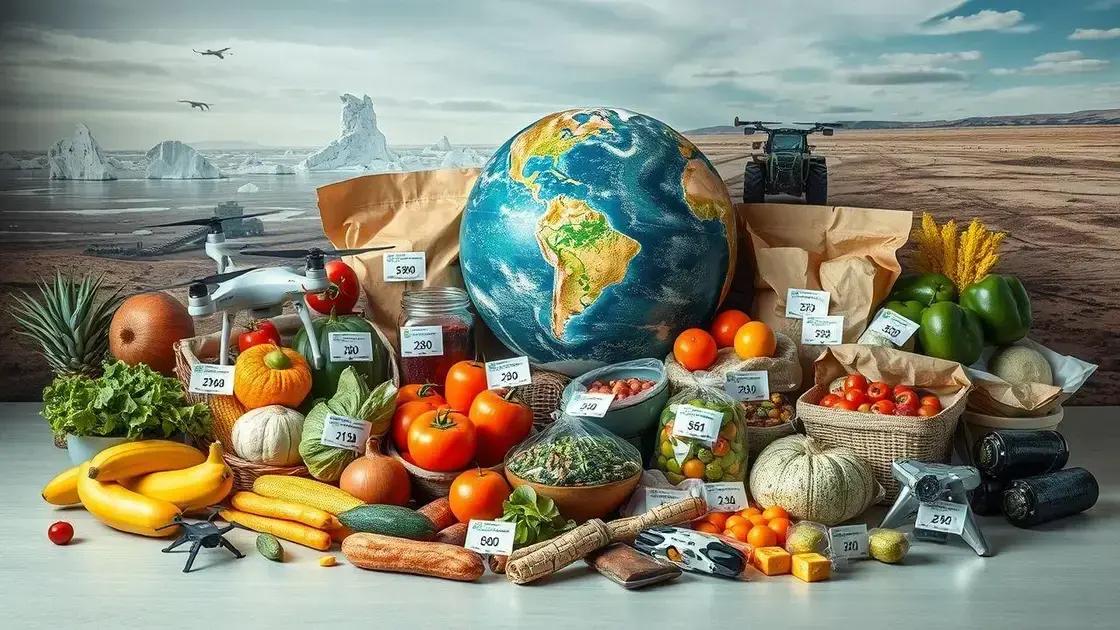Food inflation insights: navigating rising costs

Food inflation, driven by factors like supply chain disruptions, climate change, and rising production costs, significantly impacts household budgets, prompting families to adopt strategies like meal planning and smart shopping to manage expenses.
Food inflation insights are becoming increasingly important as prices surge. Have you noticed how your grocery bills keep climbing? This article dives into the reasons behind these changes and offers practical tips for managing your expenses better.
Understanding food inflation and its causes
Understanding food inflation helps us grasp why our grocery bills are rising. It’s crucial to identify the factors contributing to these price changes. Several elements impact food prices, including supply chain disruptions, weather events, and rising production costs.
Key Factors Behind Food Inflation
Many elements contribute to rising food prices. Here are some major factors:
- Supply Chain Disruptions: Issues in transportation and logistics can lead to shortages, pushing prices up.
- Weather Conditions: Natural disasters or adverse weather can affect crop yields, resulting in fewer available products.
- Increased Demand: A higher global population means more people need food, placing stress on available resources.
- Production Costs: Rising expenses for labor, fuel, and raw materials directly impact the prices consumers pay.
Moreover, global events like pandemics or geopolitical tensions can lead to market instability, which in turn affects food costs. The interconnectedness of agricultural production means that a problem in one part of the world can ripple through to consumers everywhere.
Consumer Behavior and Food Prices
Consumer behavior also plays a role in food inflation. When people anticipate rising prices, they may buy more in advance, further increasing demand. This anticipation can contribute to a self-fulfilling cycle of rising prices. As consumers adjust their buying habits, food manufacturers and retailers respond, often raising their prices to match the heightened demand.
Aside from external factors, personal choices can impact the way food inflation affects individual households. Strategies like meal planning and bulk purchasing can help mitigate the financial impact of rising prices. By understanding how to navigate these challenges, consumers can better manage their grocery budgets.
How food inflation affects household budgets

Understanding how food inflation affects household budgets is essential for managing personal finances. As prices rise, families often find themselves adjusting their spending habits to cope with increased grocery bills. This adjustment can lead to difficult choices, as families may need to prioritize certain items over others.
Impact on Household Expenses
Rising food prices can consume a larger portion of a household’s monthly budget. Here are some effects:
- Increased Spending: Families often need to spend more on basic groceries, which can strain their budgets.
- Less Variety: With higher prices, households may limit their food choices, opting for cheaper, less nutritious options.
- Shift in Priorities: Families may cut back on non-food expenses to accommodate increased grocery costs.
- Long-Term Changes: Prolonged inflation may lead families to permanently alter their shopping habits and meal planning.
Every increase in food prices can lead families to reconsider not only what they buy but how they prepare meals. For instance, families might start planning meals around sales or utilize discount grocery stores more frequently. Such changes can help manage costs, but also reflect deeper challenges in meal quality and nutrition.
Psychological Effects of Rising Food Costs
The psychological impact of food inflation should not be overlooked. As families deal with rising expenses, anxiety and stress levels can increase. This worry about budgeting can affect overall well-being. For many, food security becomes a pressing concern, leading to feelings of uncertainty.
Families with limited financial resources may feel the pinch more severely, as they have less flexibility in their budgets. With every trip to the grocery store, the pressure mounts, highlighting the direct connection between food inflation and household stress.
Strategies to cope with rising food prices
Finding effective strategies to cope with rising food prices is vital for maintaining a healthy budget. As grocery costs increase, families can employ several tactics to manage their expenses without sacrificing nutrition.
Meal Planning and Budgeting
One of the best ways to combat high prices is through careful meal planning. By deciding what to eat for the week ahead, families can avoid unnecessary purchases. Here are a few tips:
- Create a Weekly Menu: Planning meals in advance can help maximize food use and reduce waste.
- Make a Shopping List: Stick to a list to avoid impulse buys, which can quickly add to your grocery bill.
- Use Coupons and Sales: Look for discounts and promotions to get the best deals on necessary items.
- Buy in Bulk: Purchasing non-perishable items in bulk can save money in the long run.
In addition to meal planning, budgeting is essential. Setting a limit on weekly grocery spending can help families stay within their means while still providing healthy meals.
Smart Shopping Techniques
When shopping, being strategic can lead to significant savings. Consider these shopping techniques:
- Shop Seasonal Produce: Buying fruits and vegetables in season often means lower prices and better flavor.
- Compare Store Prices: Different stores may have varying prices on the same items; take time to compare.
- Opt for Store Brands: Generic or store-brand products are usually cheaper and often just as good as name brands.
- Avoid Shopping Hungry: Shopping on an empty stomach can lead to impulse buys, increasing your grocery bill.
It’s also beneficial to consider community resources. Local food banks or co-ops can provide additional support. Utilizing these resources can help alleviate some of the financial burdens caused by rising food costs.
Ultimately, being proactive and informed can make a significant difference in managing household expenses related to food inflation. Families that take time to plan and shop wisely will find it easier to cope with the challenges posed by high prices.
Future trends in food inflation

Understanding future trends in food inflation is essential for consumers and businesses alike. As the world changes, the forces driving food prices will also evolve. Recognizing these trends can help households adapt their budgets and shopping habits effectively.
Global Economic Factors
The global economy plays a significant role in influencing food inflation. Factors such as trade agreements, currency fluctuations, and international demand can lead to price changes. For instance, if a country faces economic sanctions or trade barriers, the costs of imported food may rise. These shifts often trickle down to consumers, leading to increased grocery bills.
Technological Innovations
Innovations in agriculture and food production can impact prices as well. Advancements such as precision farming and biotechnology can improve crop yields and reduce costs. As these technologies become more widespread, they may help stabilize prices or even lower them long-term. Additionally, improvements in logistics and supply chain management can reduce waste and keep food prices more stable.
Consumer Behavior Changes
Consumer preferences also shape food inflation trends. The rise in demand for organic foods and plant-based options has influenced pricing. As more people opt for healthier choices, this shift can lead to changes in supply, affecting overall costs. Moreover, awareness of sustainability issues might push prices higher as producers adapt to environmentally friendly practices.
Moreover, if inflation continues, consumers may shift their choices, opting for budget-friendly options or simpler meals. This adaptability can influence what food producers prioritize, potentially impacting long-term pricing structures.
Impact of Climate Change
Climate change remains a critical factor influencing food prices. Changing weather patterns can affect crop production, leading to shortages and higher prices. As extreme weather events become more common, farmers may face challenges that can lead to increased costs passed on to consumers. The need for sustainable farming practices will only grow as we acknowledge these challenges.
In summary, staying informed about future trends in food inflation will empower consumers to make smarter decisions and adjust their spending as the market evolves. Adapting to these changes not only helps manage household budgets but also promotes long-term financial health.
FAQ – Frequently Asked Questions about Food Inflation
What are the main causes of food inflation?
The main causes of food inflation include supply chain disruptions, increased demand, rising production costs, and climate change.
How can families cope with rising food prices?
Families can cope with rising food prices by meal planning, budgeting, using coupons, and buying in bulk.
What impact does technology have on food prices?
Technology in agriculture can improve efficiency and yield, potentially stabilizing or lowering food prices over time.
Why is consumer behavior important in food inflation?
Consumer behavior influences demand, which can drive prices up; awareness of spending habits can lead to smarter purchasing decisions.






